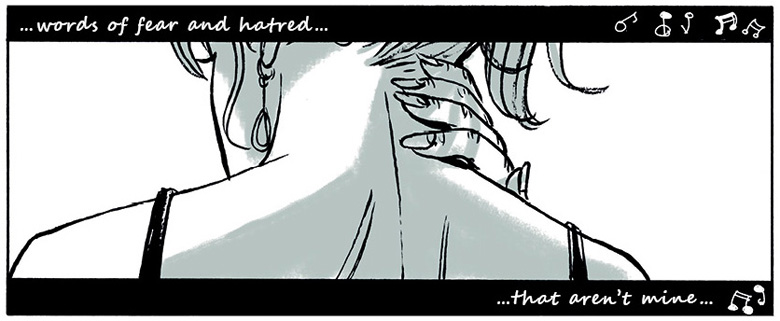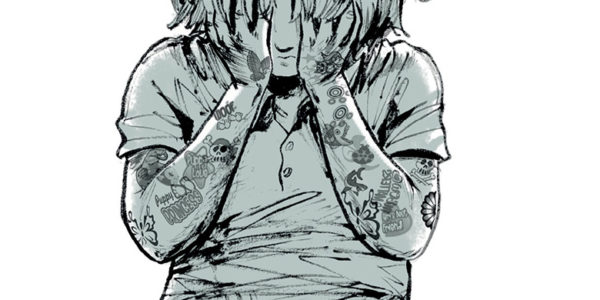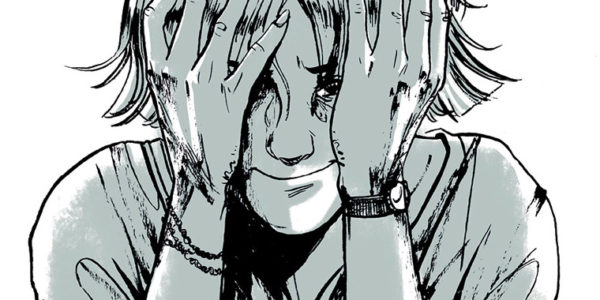Writer/artist Halim Mahmouidi is a journalist and illustrator who began his career drawing editorial cartoons for numerous French and foreign newspapers before turning to full-length graphic storytelling. His first book, Arabico, won the Bulles en Fureur Award in 2011, and is one of the top 10 news and feature reports of the 2010 France Info Prize. His second book, A Free World, is part of the permanent collection at the National Museum of the History of Immigration in France. He continues to teach courses and conferences on comics and the lower-class immigrant’s struggle.
We asked Halim some questions about his newest book, Little Mama, a touching and harrowing tale about a little girl born into an abusive household, now available from Magnetic Press.

Teen pregnancy and domestic abuse are difficult subjects to talk about. What made you want to write this story? And what does the graphic novel format bring to the conversation?
Halim: Indeed these topics are not obvious to address, but they are not insurmountable either. And they are all the more necessary because they are the pervasive symptoms in periods of crisis (economic, social, moral, etc.), like the one we are experiencing today.
I grew up in the suburbs, in a very poor working-class environment. That’s why societal issues such as poverty, domestic violence, and teenage pregnancy are familiar to me. Before doing comics, I was a social worker for three years. So I know and understand very well the structural mechanisms of oppression generated or suffered by institutions, groups, or individuals. It is something I have always been sensitive to.
Ultimately, the need to address domestic abuse came about because I am the father of three children that I adore. So when a recent news report brought to light many cases of abuse, torture, and infanticide, the world became less bearable. These horrible incidents hurt me to my core, in my Father’s Heart.
According to a UNICEF report dating from 2018, 75% of the children in the world (about 300 million) are abused, although there are disparities between countries. But these brutalities take place every day, and to be aware of it is untenable! I decided to write this book in particular because of little Marina Sabatier, who died at the age of 8 from beatings by her parents in August 2009. In May, the police had interviewed and filmed the little girl, but they did not see that she was protecting her parents, who would ultimately kill her four months later… The courage of this little girl literally broke my heart. And she also inspired the story of “Little Mama”, a story of courage and unconditional, pure, and innocent love that children have for their parents. I had to tell that tale. I haven’t given up hope that one day, adults will be as compassionate as children. We share the same humanity; children are part of us.
The graphic novel is an ideal medium to deal with this kind of complexity, showing what is truly physical and psychological abuse. And to take the time to read it is akin to “facing” an issue, as hard as it may be. This literary immersion is greatly facilitated by the unique flow of a graphic novel. It is an invitation to travel, which offers all the time necessary to tell/read, and to enter a story, body and soul. And with the heart. That’s why I deeply love this medium, and it seemed appropriate to tell Brenda’s story.

While the subject matter may seem very heavy on the surface, you balance the periods of anguish and darkness with moments of childlike wonder, hope, and glee. How to you maintain that balance from tipping in either direction?
Halim: Indeed. That narrative balance is very present in this book. And always on the edge of good and evil, oscillating between the light and darkness of human emotion. I admit that it is very difficult to build such a story, when we know the many cognitive biases that can lock us into a single way of thinking or seeing the world. That’s why it was important for me to tell this story without judgment, neither partial nor definitive.
This was very important to me, and I wanted that. As a reader, I like dense and complex stories that illustrate the reality of a situation on its own, but in its entirety. With hindsight and empathy. Through a palette of all of the characters and human emotions in order to tell a nuanced story.
So I try to put myself in my characters’ shoes, to feel what they feel, what they live. I am very much informed before beginning a story, to dive into this world and live inside of it.
And in that way, I “become” the child, the adult, the friend(s), or even the setting (which has its own history and personality). For me, even Vincent’s dog, Ruskov, has a soul and a way of “being” all his own. It’s a character in its own right.
All this helps me write a scenario that, in my eyes, will ring true. And when everything is installed and solid, I’ll rewrite this scenario again with drawings. By tightening this balance a little more, like its own ecosystem.
I am convinced that people are not born bad or dangerous. But that they are at first in danger of themselves. And unfortunately, they can become dangerous for those around them. In psychology, the “Karpman Triangle” has shown that many persecutors are, in fact, former victims… and that even the “savior” (hero, institution, etc.) participates – despite themselves – in both the problem and the solution. This complexity (updated by “transactional analysis”) explains why all human relationships are multi-faceted and difficult to summarize. All is not black or white, there is no absolute right or wrong, no good or bad. And since a conflict is a system that feeds upon itself, all these components (characters) share the harm or the responsibility of this system.
It was through this human prism that I wanted to approach Little Mama. By asking the question, not of individual responsibility, but the responsibility of the group, the institutions, and the society to which we have delegated the power to do everything necessary to take care of each and every one of us. All of us! Because every life counts, in fiction as much as in reality.

Your other books have young protagonists too, often going through difficult challenges growing up in our modern world. What draws you to writing such poignant social tales from a young character’s perspective?
Halim: Yes, it’s true. I don’t know what drives me to write from the point of view of young characters. I didn’t really think about it at the time…
You know, in hindsight, I have a hard time seeing older people as “old people,” and I find that sometimes they are even more open-minded, or even “younger” in their minds, than many young adults. I have the impression that age is not necessarily a criterion of maturity. Just as I have difficulty recognizing the criteria of superior intelligences to other species (animal intelligence for example). It seems to me that humans are a changeable being. And that each person acts and behaves according to the circumstances they encounter rather than according to their age or their maturity level. I think all of this is variable, and based on individual context.
At the moment, I’m writing about another era (Hollywood in the 20s and 30s), so I think I can change time periods without getting stuck on contemporary issues. But you’re right, it’s true that I like characters that meet difficult challenges. Those who find themselves on the margins, excluded, or fighting against a system that oppresses them. I am attracted by these “outsiders”. They are true heroes for me, because they are like us, and they build their lives with their own strengths and their humanity.
It may be because of my own childhood, but I have an unshakeable faith in humanity, our need for love and justice, and our future. Nothing affects me more than a person who fights for him or herself.

The situations these young characters find themselves in are presented with such authenticity and honesty. Did you draw these observations from any personal experiences?
Halim: My personal experience in the face of dangerous and unjust situations is what forged my sensitivity and my experience. I was not an abused child, but I was surrounded by people who suffered a lot. We were not immune to intimate or collective dramas: families were broken, paths were ruined, dreams were atomized. But despite everything, many people from my childhood neighborhood escaped and succeeded. But there are others — too many – whose lives were really destroyed.
And the hardest thing is knowing that these misfortunes are systemic, and that they reproduce almost mechanically among poor and neglected people. When they aren’t being overly criminalized by national policies shared between the “social partners” of global surveillance and punishment and a prison system built on social misery. This is what my foray into social work has painfully taught me. This “industry of suffering” that perpetuates budgets, jobs, and the “stability” of public order.
As a child, I did not understand why foreigners like us, who lived in ghettos, looked alike and were all very poor. And why we were all insulted in the media and brutalized by the police. I was too small to see it out for myself, but I was in terrible pain. I was in pain and ashamed of myself, of my parents, of our life. I grew up with this suffering because I didn’t understand it. There were no words, no books, no examples of success or happiness to make me dream even a little bit for a better future.
So it’s true that I sometimes feel that I survived childhood trauma in a certain way. As a survivor of the place where I grew up. But above all, today, to have finally found my way and a meaning to my life… that’s all that matters. A reason to live, to exist, and to be finally free…

There is a lot of subtle symbolism in LITTLE MAMA – the goldfish, butterflies – what do these things mean to you in the story? And are there other symbols in the book people might not notice?
Halim: Symbols, like metaphors, are a nice way for me to “talk” about emotions. Stories with guts and a particular dreaminess. A tale with edges halfway between dream and reality, between past and present. It seemed important and appropriate for this story I wanted to tell.
For example, the goldfish call upon our amphibian origins, the beginnings of humanity. At the beginning of life. This initial fetal stage where we bathed in amniotic fluid in our mothers’ bellies. Like a silent ocean. I found that the heroine, Brenda, could enjoy her bath, with her fish, at a very young age for exactly that sensation. This recent, unconscious “memory of home,” when she was a baby. She feels so protected from the outside world, and also in a way closer to her mother, who was singing Teri Moses’s song to her when she was pregnant.
I also liked the idea of butterflies to express the chrysalis of growing up: liberation and learning to fly on one’s own.
There aren’t really many hidden symbols in “Little Mama” but I enjoy visually symbolizing elements sometimes: for example, the supposed age of the heroine who arrives with her doll. Or the door of the Psychologist’s office that leads directly into Brenda’s mother’s apartment.
For me, the graphic novel is close to cinema. We address the senses and emotions of the reader. We can try a lot of things: unprecedented layers of subtext, freezing time, inserting quiet moments that say more than any text, or talking about the real world we know, illustrating another perspective. Another vision of reality

